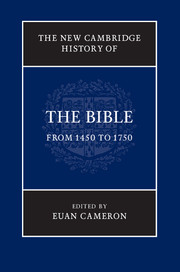Book contents
- Frontmatter
- Contents
- List of figures
- List of contributors
- Preface
- List of abbreviations
- Introduction
- PART I RETRIEVING AND EDITING THE TEXT IN EARLY MODERN EUROPE
- 1 The study of tongues: The Semitic languages and the Bible in the Renaissance
- 2 The revival of Greek studies in the West
- 3 Humanist Bible controversies
- 4 The Old Testament and its ancient versions in manuscript and print in the West, from c. 1480 to c. 1780
- 5 Critical editions of the New Testament, and the development of text-critical methods: From Erasmus to Griesbach (1516–1807)
- 6 In search of the most perfect text: The early modern printed Polyglot Bibles from Alcalá (1510–1520) to Brian Walton (1654–1658)
- PART II PRODUCING AND DISSEMINATING THE BIBLE IN TRANSLATION
- PART III PROCESSING THE BIBLE: COMMENTARY, CATECHESIS, LITURGY
- PART IV THE BIBLE IN THE BROADER CULTURE
- PART V BEYOND EUROPE
- Afterword
- Select bibliography
- Select Bible bibliography
- Index
5 - Critical editions of the New Testament, and the development of text-critical methods: From Erasmus to Griesbach (1516–1807)
from PART I - RETRIEVING AND EDITING THE TEXT IN EARLY MODERN EUROPE
Published online by Cambridge University Press: 05 August 2016
- Frontmatter
- Contents
- List of figures
- List of contributors
- Preface
- List of abbreviations
- Introduction
- PART I RETRIEVING AND EDITING THE TEXT IN EARLY MODERN EUROPE
- 1 The study of tongues: The Semitic languages and the Bible in the Renaissance
- 2 The revival of Greek studies in the West
- 3 Humanist Bible controversies
- 4 The Old Testament and its ancient versions in manuscript and print in the West, from c. 1480 to c. 1780
- 5 Critical editions of the New Testament, and the development of text-critical methods: From Erasmus to Griesbach (1516–1807)
- 6 In search of the most perfect text: The early modern printed Polyglot Bibles from Alcalá (1510–1520) to Brian Walton (1654–1658)
- PART II PRODUCING AND DISSEMINATING THE BIBLE IN TRANSLATION
- PART III PROCESSING THE BIBLE: COMMENTARY, CATECHESIS, LITURGY
- PART IV THE BIBLE IN THE BROADER CULTURE
- PART V BEYOND EUROPE
- Afterword
- Select bibliography
- Select Bible bibliography
- Index
Summary
Introduction: the surviving Greek New Testament manuscripts
Writings from antiquity, such as the Greek New Testament, have been transmitted to us through manuscripts that were copied and recopied numerous times until the printing press, by permitting the production of multiple identical copies, slowed and eventually brought hand-copying to an end. Currently some 5,500 different Greek manuscripts of New Testament writings on papyrus, parchment and paper have survived (as well as thousands of manuscript copies of translations in Latin, Syriac, Coptic and several other ancient languages). Only 1 per cent of these Greek manuscripts contain the entire twenty-seven books, because most manuscripts, as they were produced and circulated, contained a smaller group of writings, commonly the Four Gospels or the Pauline Letters, or Acts and the Catholic Letters. Surviving manuscripts, however, frequently have only a single book, as is the case with about 83 per cent of our manuscripts (excluding lectionaries) up to around 800 CE, while 15 per cent have two to nine books, and only seven manuscripts from this period (2 per cent) contain ten or more New Testament writings. Often it is not possible to tell how many writings originally occupied an individual manuscript, especially in the numerous cases where portions of only one or a few writings survive.
Then too, the quantity of manuscripts in use in Christian communities at any given time cannot be known or even estimated, yet the proportion of extant early manuscripts (from the first eight or nine centuries) compared to later surviving copies became a crucial point in the text-critical developments and controversies to be assessed below. The table shows that only 6 per cent of all surviving Greek manuscripts of the New Testament date prior to the period around 800 CE, and therefore 94 per cent were copied and utilised after that period. The table indicates also that manuscripts from the first eight centuries of Christianity very often are fragmentary: 90 per cent survive with only one to twenty-four leaves (written on both sides), so that a mere 10 per cent have twenty-five or more leaves. The size of a complete ancient codex depended on numerous factors, but volumes with significant portions of the New Testament generally contained 150 to 300 leaves.
- Type
- Chapter
- Information
- The New Cambridge History of the Bible , pp. 110 - 137Publisher: Cambridge University PressPrint publication year: 2016

